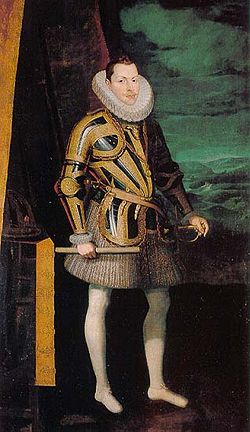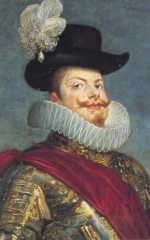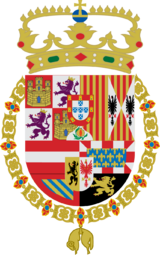Philip III of Spain
| Philip III | |
|---|---|
| King of Spain and Portugal (more...) | |
 |
|
| Reign | April 14, 1598–March 31, 1621 |
| Predecessor | Philip II |
| Successor | Philip IV |
| Consort | Margaret of Austria |
| Issue | |
| Anne, Queen of France Philip IV Maria Anna, Holy Roman Empress Infante Carlos of Spain Cardinal-Infante Ferdinand |
|
| Father | Philip II of Spain |
| Mother | Anna of Austria |
| Born | April 14, 1578 Madrid, Spain |
| Died | March 31, 1621 (aged 42) Madrid, Spain |
Philip III (Spanish: Felipe III; April 14, 1578 – March 31, 1621) was the King of Spain and King of Portugal and the Algarves, where he ruled as Philip II (Portuguese: Filipe II), from 1598 until his death. His chief minister was the Duke of Lerma. Philip III married Margaret of Austria, sister of Emperor Ferdinand II. On the eve of his death in 1621, the Portuguese empire spanned almost 2 billion acres.
Born in Madrid, the son of Philip II of Spain and his fourth wife (and niece) Anna, daughter of the Emperor Maximilian II and Maria of Spain. He shared the viewpoints and beliefs of his father, but did not inherit his industry. The hardworking and diligent old king had sorrowfully confessed that God had not given him a son capable of governing his vast dominions, and that he had foreseen that Philip III would be led by his servants. This assessment of his son ultimately proved correct.
The new king put the direction of his government entirely into the hands of his favourite, the Duke of Lerma, Francisco Goméz de Sandoval y Rojas, and when he fell under the influence of Lerma's son, Cristóbal de Sandoval, the Duke of Uceda in 1618, he trusted himself and his states to the new favourite.
The king's own life was passed amid court festivities, on which enormous sums of money were wasted, or in the practice of piety. It was said that he was so virtuous as hardly to have committed a venial sin.
He died at Madrid on March 31, 1621. The story told in the memoirs of the French ambassador Bassompierre, that he was killed by the heat of a brasero (a pan of hot charcoal), because the proper official to take it away was not at hand, is a humorous exaggeration of the formal etiquette of the court.
Contents |
Domestic Policy
The policies of the Duke of Lerma were aimed towards the maintenance of international peace, the expulsion of the Moors and personal enrichment, as much economic as political.
Throughout his reign, institutional reforms followed one after another to solve the problems of corruption and inefficiency that plagued the administration of the Monarchy: apart from the changes introduced in the traditional system of Counselors, resources were extended to the Juntas, bodies responsible for decreasing the power of royal favorites, in order to create a more agile and coherent government, but they didn't produce the desired result. The financial problems that Philip II had left behind made the king dependent on the Cortes, who had to meet more frequently than their predecessors in order to grant the resources to run the empire.
The most significant domestic policy acts during the reign of Philip III were the expulsion of the Moors from the Iberian Peninsula and the adoption of the coins of a copper and silver alloy for domestic money transactions.
Expulsion of the Moriscos (1609–1614)
|
||||||||||||||||||||||||||||||
In 1609, Philip issued a decree for the expulsion of the Moriscos (descendants of Muslims who converted to Christianity) from Spain. The idea was proposed by Juan de Ribera, Archbishop and Viceroy of Valencia. Reasons included:
- Accused collaboration with the Barbary Pirates to attack the coast
- Their unpopularity among the people, especially in Valencia
- The gain to the royal treasury from seizing the assets of 4% of the population
Between 1609 and 1614 they began to leave the peninsula. To accomplish this, the Navy and 30,000 soldiers were mobilized with the mission of transporting the Muslims to Tunis or Morroco. Approximately 300,000 Moriscos were expelled.
This measure significantly damaged the economies of the Kingdom of Valencia, Aragon, and Murcia. The cheap labor and the number of rent paying owners in these areas decreased considerably. The cultivation of sugar and rice had to be substituted for white mulberry, vineyards, and wheat.
The Dismissal of the Duke of Lerma (1618)
In 1618 the corruption grew to an intolerable level in the Court of Madrid. The King dismissed the Duke of Lerma and named the duke's son as his successor, the Duke of Uceda, whom he sent to detain Rodrigo Calderón, a figure emblematic of the administration of his father.
International Policy
England

With the ascension to the throne of James I of England, succeeding his cousin Elizabeth, it became possible to end the Anglo–Spanish War which had been dragging on since 1585 and was far too costly for both countries. In August of 1604 the Treaty of London was signed.
Netherlands
Philip II of Spain had bequeathed this remaining territory in the Southern Netherlands to his daughter Isabella Clara Eugenia of Spain and her husband, Archduke Albert, under the condition that if she died without any heirs, the land would return to the Spanish Crown. The equality of forces between the rebellious provinces of the north - Calvinist Protestants - and the southern provinces - allied with Spain - led to war exhaustion and in 1609 to a truce that was to last for twelve years, also known as Pax Hispanica. The truce did enable the Southern Netherlands to recover, but it was a de facto recognition of the independence of the Dutch Republic and did not stop its commercial and colonial expansion into the Caribbean and the East-Indies, although Spain had tried to impose the liquidation of the Dutch East India Company as a treaty condition. Minor concessions of the Dutch Republic were the scrapping of the plan to create a West India Company and to stop the harassment of the Portuguese in Asia. Both concessions would appear to be temporal.
France
With the death of Henry IV of France - a supporter of the war against Spain - a period of instability commenced in the Kingdom of France.
Italy
The Duke of Osuna, viceroy of Naples, the Marquess of Villafranca, and the Governor of Milan directed the Spanish policy in Italy that encountered resistance from the Kingdom of Savoy and the Republic of Venice. To secure the connection between Milan and the Netherlands a new route was opened through Valtelina, Switzerland and in 1618 the plot of Venice occurred in which the authorities engaged in the persecution of pro-Spanish agents.
Thirty Years' War
Confrontation between the Catholics and Protestants in Bohemia.
Intervention of Philip III of Spain (1618–1621)
Emperor Ferdinand II Habsburg asked the Spanish branch of his family for help to put down the rebellion of the Protestant Czechs.
Spain, allied with Austria and Bavaria confronted the Bohemian Protestants supported by the Electoral Palatinate. The Spanish troops headed by Ambrosio Spinola in the Palatinate and by Johann Tserclaes, Count of Tilly in Bohemia, achieved victory against the Czechs in the Battle of White Mountain.
Ancestors
| Philip III of Spain, II of Portugal | Father: Philip II of Spain, I of Portugal |
Paternal Grandfather: Charles V, Holy Roman Emperor |
Paternal Great-Grandfather: Philip I of Castile |
| Paternal Great-grandmother: Joanna of Castile |
|||
| Paternal Grandmother: Isabella of Portugal |
Paternal Great-Grandfather: Manuel I of Portugal |
||
| Paternal Great-Grandmother: Maria of Aragon |
|||
| Mother: Anna of Austria |
Maternal Grandfather: Maximilian II, Holy Roman Emperor |
Maternal Great-Grandfather: Ferdinand I, Holy Roman Emperor |
|
| Maternal Great-Grandmother: Anna of Bohemia and Hungary |
|||
| Maternal Grandmother: Maria of Spain |
Maternal Great-grandfather: Charles V, Holy Roman Emperor |
||
| Maternal Great-Grandmother: Isabella of Portugal |
Family
Philip married Margaret of Austria. They had the following children:
| Name | Birth | Death | Notes |
|---|---|---|---|
| Anna Maria Mauricia | September 22, 1601 | January 20, 1666 | Married Louis XIII, King of France (1601–1643) in 1615. Had issue. |
| Maria | February 1, 1603 | February 2, 1603 | Died in childhood. |
| Philip IV, King of Spain | April 8, 1605 | September 17, 1665 | Married (1) Elisabeth of Bourbon (1603–1644) in 1615. Had issue. Married (2) Mariana of Austria (1634–1696) in 1649. Had issue. |
| Maria Anna Margarita | August 18, 1606 | May 13, 1646 | Married Ferdinand III, Holy Roman Emperor (1608–1657) in 1631. Had issue. |
| Carlos | September 14, 1607 | July 30, 1632 | Died unmarried. |
| Ferdinand | May 16, 1609 | November 9, 1641 | The Cardinal-Infante. He had an illegitimate daughter (nun). |
| Margarita Francisca | May 24, 1610 | March 11, 1617 | Died in childhood. |
| Alfonso Mauricio | September 22, 1611 | September 16, 1612 | Died in childhood. |
See also
- Juan Bautista de Toledo
- Juan de Herrera
- Sofonisba Anguissola
- Escorial
References
- This article incorporates text from the Encyclopædia Britannica Eleventh Edition, a publication now in the public domain.
- See also Philip Allen, Philip III and the Pax Hispanica.
|
Philip III of Spain
Born: 14 April 1578 Died: 31 March 1621 |
||
| Regnal titles | ||
|---|---|---|
| Preceded by Philip II of Spain I of Portugal |
King of Spain 1598 – 1621 |
Succeeded by Philip IV of Spain III of Portugal |
| King of Portugal and the Algarves 1598 – 1621 |
||
| Spanish royalty | ||
| Preceded by Diego |
Prince of Asturias 1582 – 1598 |
Succeeded by Philip (future Philip IV of Spain) |
| Portuguese royalty | ||
| Preceded by Diego |
Prince of Portugal 1582 – 1598 |
Succeeded by Anne |
|
||||||||||||||||||||||||||
|
||||||||||||||||||||
